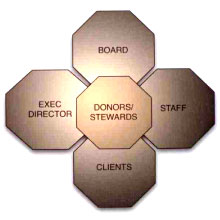Building Board Bonds
Principles for strengthening the CEO-board relationship
You are a mission leader. As an executive director, president, or CEO, you have succeeded in a difficult field for a few years or for many. You have led a ministry to the poor, hungry, homeless, and addicted. This is no small feat. These are difficult people in difficult situations during difficult days.
At the same time, you have led a staff of caring yet imperfect people. Although from diverse backgrounds, they have a common goal: to serve with passion. Some may have experience in ministry or in the corporate world; others learn as they go.
Thanks to you, the mission has resources to keep going for a number of years. Building relationships with donors, analyzing campaign results, and keeping development staff around is a difficult and draining pan of your job.
You are succeeding at these very demanding tasks. But one thing is troubling: You can't get along with your mission board.
Toward success
To have a successful relationship with your board, you must have a solid understanding of the purpose, function, and tendencies of a nonprofit board.
First, the board of directors is the true owner of your rescue mission. If you are a powerful personality who has built the mission up for many years, this may come as a shock to you. But no individual owns a ministry that is a nonprofit organization. The board is the legal owner.
In addition, recognize that the board members are very part-time volunteers. Yes, they may love the mission and be very generous, but when they leave the board meeting, most are on to the rest of their lives.
If you can count the hours of the board meeting, their preparation for the meeting by reading the committee and staff reports (no clearing or throats here, please), and other functions, a board member gives four to seven hours per month thinking about the mission. This, however, does not mean they do not care.
Board members also know very little about the ministry of rescue. They may know a great deal about components of your mission, such as finances, facilities, and program but they are not experts in the trends of social service, addiction recovery, development, and the other issues you face on a daily basis.
Successful in their field or ministry, many board members are used to being listened to and having control to direct decisions and outcomes. Many have owned their own businesses, or have been in key leadership positions.
Alternately, you may have board members who used to listening to you and doing nothing else. These board members give you anything you ask for, and trust you know what you are doing. This does not make for a healthy relationship.
The board can either be a great member of the rescue mission leadership team, or it can be the greatest resistance to progress, a distraction, and waste of your time as a leader.
A True Team
 Each member of your team executive director, clients, staff members, board member, and donors has a role. They must work together. They must have boundaries yet show flexibility. The must honor the relationships with the other team members. They must know their responsibilities and accomplish them.
Each member of your team executive director, clients, staff members, board member, and donors has a role. They must work together. They must have boundaries yet show flexibility. The must honor the relationships with the other team members. They must know their responsibilities and accomplish them.
The older hierarchical model in which one group is at the top and the others line up nicely in submission is no longer appropriate. Work does not get done this way. I recommend reading Good to Great and the Social Sectors: Why Business Thinking Is Not the Answer (HarperCollins, 2005) by Jim Collins for more information.
Forming a strong, healthy CEO-board team involves understanding appropriate roles, expectations, relationships, values, trust, and proactive communication.
Roles
Defining roles is a key component in understanding and building a team.
The board is a group of people that offers oversight, governance, and leadership involvement. These leaders stay at the 30,000-foot level; they do not get involved in management details.
The CEO/executive director engages in proactive communication with board members, leaders, and management of mission, making the owners (the board) a priority. While that may not seem like it should be the top priority, it is. If the board is happy, the rest of the organization is happy. After this key job, the CEO is responsible for leading and managing the day-to-day work of the mission everything else.
The board and CEO each have a relationship with the program (that carries out the mission statement) and the development and financial strategies to keep the mission strong.
Expectations
This key word can be the joy or pain of the relationship between the board and CEO/executive director.
The board expects the executive director or CEO to guide and implement ministry goals, financial standards, development goals, philosophy, and short- and long-term timelines for implementation. The board also expects he or she will oversee and implement a great program and supporting infrastructure.
The board's expectation is that the chief executive will either do the things personally or find staff who know how to take care of these areas. These areas demand study, experience, and a professional approach.
The executive director expects the board to provide leadership, support, oversight, and direct involvement where necessary; he or she generally expects the board to stay out of management.
Relationships
Board members should have a healthy relationship with their executive director or CEO. They expect to listen to a leader and expert at the meetings. They want him or her to be a spiritual leader and to be faithful under stressful situations.
The director expects the board to take the role of owner seriously. While board members are the bosses, they also come alongside and are partners in the battle to save lives. They should be encouragers as well as hold the director accountable when appropriate.
Values
The ministry's mission statement, compassion for the poor, integrity, and financial stability should be a board member's priorities. Everything else can be taught or learned. If a board member does not have these values, he or she should not be on your board.
The board believes the directors values should be focused on implementing the mission statement. As well, the leader should be concerned about staff integrity, systems, programs, effective development, and financial standards. He or she should esteem excellence in all areas of the mission.
Trust
It's critical that the ministry board believes the director or CEO will do all he or she can to carry out the mission statement with which he or she has been entrusted.
Likewise, the director needs support from the board to ensure the leader will have all that he or she needs to carry out the mission statement. The director trusts the board to be there in the good times and in the bad. Board members' support getting to meetings, accomplishing goals, approving budgets, and the like is essential for the ministry's operation.
Proactive Communication
Solid communication is essential to have a well-informed and effective board. Each board member must b informed and up to dale with reports, committees, and information about the mission and role of the board.
The executive director or CEO must keep the board informed to ensure board members have necessary information to fulfill their roles. And the director should have a reasonable expectation that this proactive communication is read.
???
While your relationship with your board may sometimes be difficult, it is critical for the effectiveness of your ministry. Place priorities on clear expectations, relationships, shared values, trust, and proactive communication to make the most of this important relationship.
